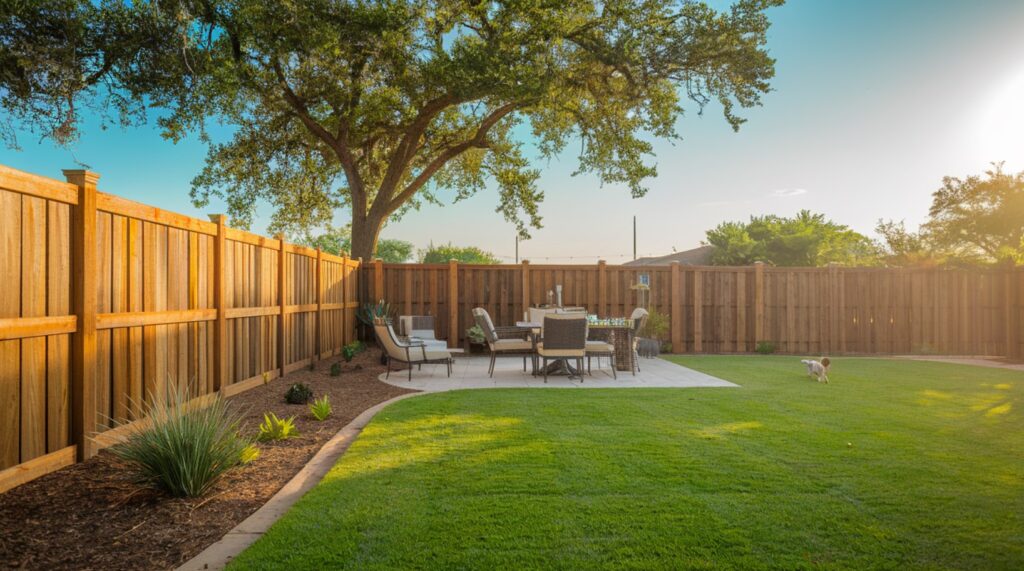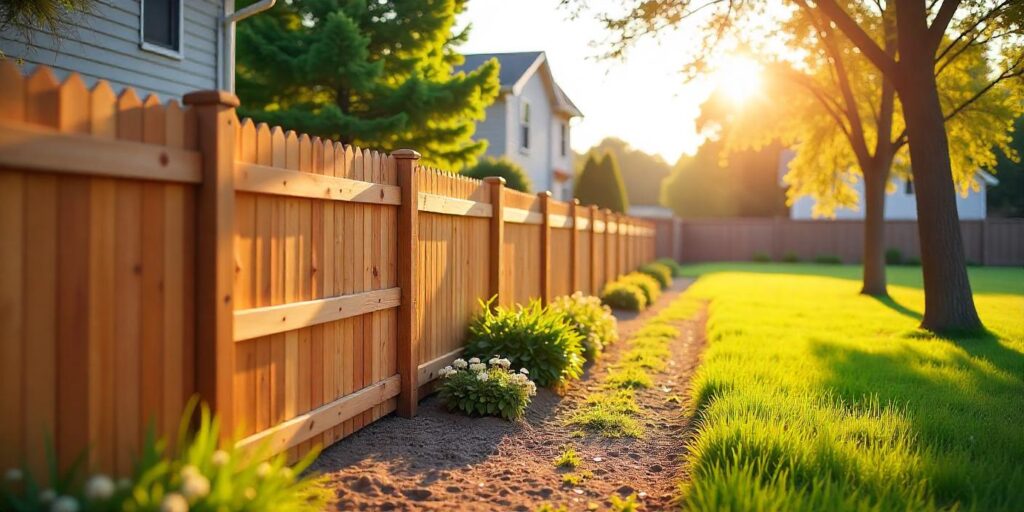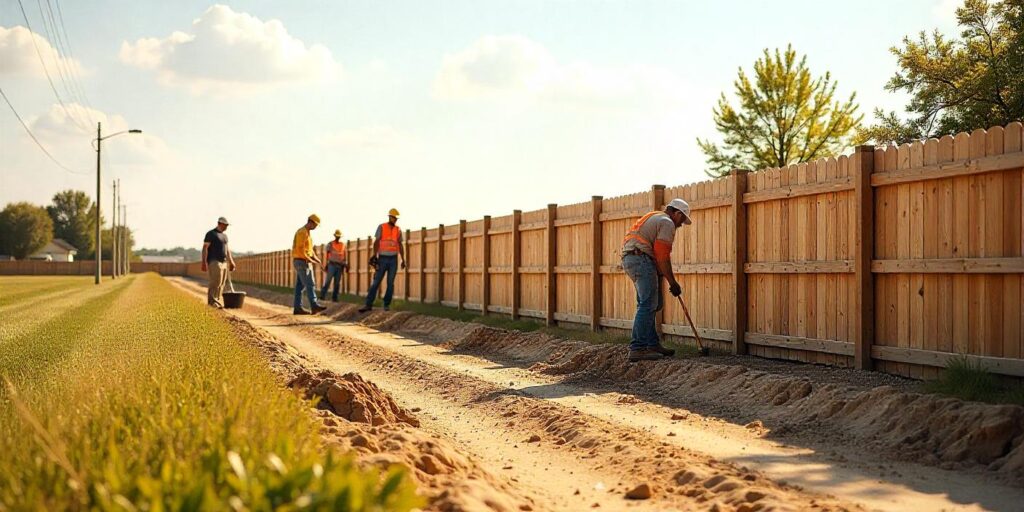If you are thinking about a fence installation in Houston, you are in for a treat. A good fence will make life a lot easier. It will keep your dog safe, prevent nosy neighbors from looking in, and make your yard more appealing.
You can have something cool like custom wood gates or tough like chain-link. However, if planning goes wrong, you may end up with a hell of a headache. There can be all the types of annoyances, including legal requirements, overspending, and a fence that can’t stand up to the heat. Understanding certain basic things will save you a lot of trouble.

home with a sturdy fence installation
Why a Fence Matters for Your Property
Dependable fence installation in the Houston, and surrounding areas can be found by going with an expert with years of experience who can provide a seamless installation, from start to finish, and therefore assure you that everything will be done right the first time around, instead of just mostly planting posts deeply into the ground.
From making material selections to overcoming the cement traps, we are right there with you. Plus, we plug in extras like deck installation or staining services to take your entire outdoor experience to the next level. Fence smart with a top fencing company? Let’s dive in!
1. Fence Laws & Regulations
Houston takes fence rules seriously, and they can be a bit tricky if you’re not prepared. Let’s break it down into sections so you’re sure your fence installation in Houston doesn’t run afoul of the law and all other variants.
Open Range Rules: Do They Apply to You?
Various in the rural areas, the old-fashioned open range laws think cattle wandering about free unless fenced out. For urban areas like Houston, that’s not an option, but you might just want to check your county if you’re out in the country. Your setup might need to be some kind of livestock-proof.
Local Codes: Houston, San Leon, and More
Houston’s municipal laws differ greatly from one another:
- Houston: Front yard barrier limited to 3.5-4 feet (1.07-1.22 m); backyard barrier may reach 8 feet (2.44 m) if not adjacent to a street.
- San Leon: Additional limitations on barrier height and design apply to waterfront properties.
- League City: Barriers close to specific intersections must be 70% open.
Our staff keeps up with the local barrier codes, so your installation will continue to satisfy your demands and be completely compliant.
HOA Restrictions: Navigating Neighborhood Rules
The strictest barrier laws are frequently enforced by homeowners’ associations, and they include:
- Material restrictions (permitting just certain kinds, such as ornamental iron).
- Limitations on height (usually no more than 6 feet).
- Design requirements (mandatory gaps, specific colors).
- Approval processes before installation begins.
Finding an answer that meets the strictest HOA regulations in Houston is essential. After carefully reviewing your HOA documents, you can design a fence that fits your concept and complies with requirements.
Pool Safety Fencing: Legal Requirements
Fencing of swimming pools in Houston has very specific requirements according to city ordinances:
- Minimum 4-foot height (1.22 m).
- No gaps larger than 4 inches.
- Self-closing, self-latching gates.
- Non-climbable design.
These are safeguards to protect your children and pets and to allow homeowners an exclusion from liability for certain types of acts. Code-compliant pool walls may add to outdoor decor while providing maximum safety.
Spite Fences: Don’t Build to Annoy
In Houston, a fence built solely to annoy a neighbor-known as a “spite fence”-may face legal challenges if it lacks a legitimate purpose. To maintain compliance and steer clear of possible problems, make sure your fence fulfills a useful purpose, such as offering privacy or security.
Easements & Setbacks: Critical Boundary Considerations
Fences that are installed across public rights-of-way or utility easements may need to be removed or relocated at your expense. Important things to think about include:
- Utility easements (typically 5-10 feet from property lines).
- Road setbacks (often 15-25 feet from street centerlines).
- Drainage easements (especially important in flood-prone areas like Houston).
By identifying all easements prior to the start of design, our expert survey method helps to avoid expensive errors.
2. Planning Your Fence Installation
Getting it right starts with a solid plan-skip this, and you’re asking for trouble. Here’s how to set up for success:
Picking a Purpose: Privacy or Style?
Why do you want a fence? Style might go toward handcrafted wood gates for that ranch feel, while privacy might need tall wood to prevent Houston traffic noise. Nail your goal before the first post goes in. Different needs require different barrier solutions:
| Primary Need | Recommended Fence Types | Key Features |
| Privacy | Cedar, vinyl, composite | solid panels |
| Security | Wrought iron, chain link with privacy slats | Height, difficult to climb, gates with secure locks |
| Boundary marking | Aluminum, ranch-style, decorative | Lower height, partial visibility |
| Noise reduction | Wood with acoustic treatments | Tightly fitted panels, mass for sound blocking |
| Curb appeal | Ornamental steel, custom wood | Decorative elements, premium finishes |
Identifying your specific needs can guide the selection of the ideal fence type for your Houston property.
Finding Your Property Line
It’s appropriate to have good knowledge of what your property line is to prevent conflicts with adjoining neighbors that could necessitate the costly removal and relocation of a fence. Check to see where your deed specifies the boundaries, or hire an expert surveyor to ensure that the conflict does not ever escalate to the point that costly legal entanglements ensue over something many may consider trivial-a fence-offering great relief both in time and expense, mitigating arguments, and maintaining good relations with your neighbors.
Permits: Do You Need One?
Make sure to find out if there are permits for fences in Houston so that you avoid being fined and forced to take it down. Requirements vary by city, and in fact, Houston requires some sort of approval, especially if the height of the fence happens to be larger. The best way to run a smooth project is just to contact your local municipality or HOA.
Chatting with Neighbors First
From a neighborly standpoint, it’s good to discuss putting your fence in place with others. In Houston, a city that services claimed boundary concerns, including where walls will be or what they will appear like, this may avert conflicts and guarantee collaboration and seamless operations.
3. Best Fence Types
Fences here have to take some beating and still look good-your setup just has to fit. So here’s what works best under that big sky.
Wood Fences: Why Custom Wood Gates Shine
Wood is a traditional material; consider sturdy cedar or pine, which can add a classy touch to the privacy and ranch feel of wood fencing. Custom wood gates take it a notch higher because they provide for anxious styles and strongholds for Houston backyards or San Leon spreads.

Classic wooden fence made of sturdy cedar or pine.
Chain Link: Tough and Ready
Chain-link fencing is a direct, cheap, and durable option for heating and ranch homes, making it also a suitable option for lightweight security. This is by far the easiest way to go for durability through those summers in Houston.
Vinyl Fences: Easy Care for Hot Climates
Vinyl exhibits exceptional resistance to sun exposure, resisting warping and fading in contrast to wood. Its minimal maintenance requirements make it an excellent choice for homeowners with demanding schedules, offering reliable options suitable for regions from Houston to San Leon.
Metal Fences: Strength for Storms
Metal-think wrought iron-stands tall against storms and winds. It’s tough, classy, and perfect for a setup that screams durability, wherever you’re at.
4. Getting Your Yard Ready
Your yard needs prep before work begins-skip it, and you’re in for a mess. Here’s how to set the stage:
Dial 811: Utility Check Before You Dig
Digging blind can hit gas lines or cables-call 811 first. It’s free, fast, and keeps your project safe, whether in Houston or San Leon. This free service marks all underground utilities, preventing:
- Dangerous gas line strikes.
- Costly water line damage.
- Service-disrupting fiber optic cuts.
- Electrical hazards from buried power lines.
All utility marking and schedule installation only after confirming safe digging conditions-protecting both your property and our installation teams.
Clearing Space
A clear yard is essential-remove rocks, trim bushes, and mark your installation spot. Clutter can delay the job, so make sure everything is ready for a smooth process.
Weather: When to Install
The quality of barrier placement is greatly impacted by strategic timing:
Houston’s Best Seasons for Installation:
- March through May is the ideal time of year for soil moisture and mild temperatures.
- Fall (September–November): There is little rain and great working conditions.
- Generally speaking, winter (December- February) is good, with the exception of freeze events.
Problems Associated with Installation Conditions:
- Extremely high temperatures necessitate special concrete curing protocols for summer installation.
- Installation following heavy rain may have to be done with soil adjustment to keep from sinking.
Installation is scheduled during optimal conditions, with specialized techniques used as needed for off-season projects.
Drainage Fix: Adding a French Drain
French drain service prevents fences from sinking in wet yards. Combine it with your setup for a long-lasting, dry, and consistent result.
5. Budgeting for a Fence
Fences are an expensive proposition, but with planning, you can avoid costly surprises. Make sure you are aware of the following before you start.
How Much Does It Cost?
Fences cost between $1,856 and $4,760 on average, and most are around $3,218. They vary based on material and length:
- Wood fences: $10 to $30 per foot—affordable and classic.
- Metal fences: More expensive but durable—prices vary by type.
Extra Costs: What Homeowners Miss
It’s not just about putting up a fence. Extra costs can add up quickly:
- Permits: These can range from $100 to $500 based on local rules.
- Gates: Budget $200 to $600 for each gate.
- Land grading: If your yard isn’t level, it may cost $1,000 to $3,225 to fix.
- Old fence removal: Removing an old fence costs about $3 to $7 per foot.
Staining Services: Worth It?
Wood fences need protection. It keeps them from fading and rotting. It will cost you between $750 and $4,250 depending on the size of the fence. Without it, your fence may need to be repaired or replaced sooner.
Payment Plans
If a total payment isn’t in your budget, most companies have payment plans or financing available. Breaking up the expense helps you afford the fence you desire without the financial strain. Prepare in advance, understand the costs, and you won’t be left with any surprises. Preparing now can save you a great deal of money later on.
6. The Fence Installation Process
It’s not planks and posts-it’s a process with a twist. This is what happens when you fence up:
What Happens on Installation Day
Day one, and the crew posts, digs, and sets posts-your fence takes shape in a matter of hours. On urban streets and in suburban towns, the crew gets the job done efficiently and leaves the site spotless.
How Long Jobs Take
Most barriers-100 feet-will be wrapped in 1-3 days depending on soil or weather. Big jobs or special wood gates might stretch it out; professionals have schedules you can depend on.
Checking Your New Fence
After installation, test every detail-gates swing, posts stand firm, and there is no wobble. Your fence is ready for cattle, kids, or killer looks, built with our rock-solid guarantee.

Fence Installation Process
7. Fence Installation Mistakes to Skip
Learning from others mistakes guarantees your barrier project succeeds. Below are major mistakes to avoid based on our years of installation expertise.
Permit and Regulation Oversights: Legal Pitfalls
Common regulatory mistakes include:
Regulatory errors include:
- Installation without the necessary permits (usual in Houston and regulated subdivisions).
- Exceeding height limitations without variances.
- Overlooking setback requirements along roads and property lines.
- Failing to obtain HOA approval where required.
Consequences:
- Fines ranging from $500 to $2,500.
- Compulsion to remove or change barriers.
- Conflict with the authorities or neighbors.
- Property sale complications during title searches.
All work on permits is performed by professionals to ensure absolute compliance with regional codes before installation.
Messing Up Property Lines
Boundary errors are the most expensive barrier errors:
- Reliance on visual cues rather than questionnaires.
- Using out-of-date property information.
- Construction on boundary lines without regard to legal repercussions.
- Neglecting to consider easements and setbacks.
Consequences
- Compelled barrier relocation (expense usually over $3,000).
- Neighbor disputes and potential litigation.
- Complications in property sales.
- Utility access issues requiring barrier adjustment.
These processes include boundary verification before design finalization, preventing these costly errors.
Picking Weak Materials
Using inappropriate materials results in premature barrier failure:
- Using regular pressure-treated wood instead of posts rated for in-ground use.
- Insufficiency of lightweight barrier panels in windy conditions.
- Installation of non-galvanized chain link in coastal areas.
- Using interior-grade hardware that corrodes quickly outdoors.
Consequences
- Decreased barrier lifespan (sometimes by 50+ years).
- Increased maintenance requirements and costs.
- Early replacement needs.
- Structural failures create safety risks.
Experts only use weather-specific materials suitable for Houston conditions to obtain the best functionality and durability.
DIY Installation Problems
Self-installation typically presents special problems:
- Insufficient post depth for clay soil expansion/contraction.
- Incorrect concrete mixing in harsh temperatures.
- Insufficient hardware sizing for wind resistance.
- Incorrect panel spacing due to wood expansion in humidity.
Consequences
- Leaning or heaving barrier due to weather cycles.
- Ground-level premature wood decay.
- First major gate failure of wind event.
- First-year panel warping and splitting.
Professional installation ensures proper methods specifically designed for your local soil type and microclimate.
 Alt text: Fence Installation Mistakes to Skip
Alt text: Fence Installation Mistakes to Skip
FAQs
Need answers to your project? I have answers- straight-up facts to set the record straight.
– Do You Need a Permit for Installing a Fence in Houston?
Permits depend on the location:
- Houston: Permits are required for a barrier over 8 feet in height and for all pool enclosures.
- San Leon/Galveston County: Permits and wind-resistant construction are needed for waterfront homes.
- League City: Permits are required for a barrier over 6 feet and in flood control zones.
- HOAs: Require approval almost invariably regardless of the municipality’s requirements.
All permitting is done by professionals as part of our total service and in full compliance with regional codes.
– What Is the Maximum Legal Fence Height in Houston?
Height limits vary by jurisdiction and by barrier location:
- Front yard: Generally limited to 3.5-4 feet (varies by city).
- Side/back yards: Typically, 6-8 feet at most, except with special permits.
- Corner lots: Often have visibility triangle limitations at intersections.
- Pool enclosures: State law mandates at least 4 feet.
Our design experts ensure your barrier meets legal requirements and your daily needs.
– What Is Best for the Weather?
Storms and heat love vinyl or wood—metal works too with staining services. Experts recommend specific materials based on your specific site conditions.
– Can You Split Fence Costs with Your Neighbor Legally?
Houston fence cost-sharing works as follows:
- No legal requirement to share barrier expenses between neighbors.
- It can be made voluntary by signed agreements.
- Shared fences are jointly owned property and require mutual consent for changes.
- Good neighbor fences (same appearance on each side) tend to promote willingness to share costs.
Professional team can provide sample cost-sharing agreements and negotiation methods if you prefer to approach the neighbors with a request to share costs.
– How Do You Choose a Trustworthy Fence Contractor in Houston?
Search for a licensed and experienced fence contractor in Houston who understands the local conditions and has positive feedback, such as Standard Fence. Obtain at least three estimates, verify insurance, and have a good warranty to cover your fence installation.
Conclusion
Ready for a fence installation at your property? Need a fence for Houston privacy, San Leon security, or a style upgrade? Preparing in advance and knowing fence laws makes it a smooth process. We’ve outlined the rules, the costs, and the top barrier materials so your fence installation holds up and shines.
At Standard Fence, we guide you through your fence installation- from cracking open neighborhood fence codes to picking the right fence style. Our professionals understand how to build fences to survive Houston weather and stand upright for decades.
Don’t risk costly mistakes-talk to our experts today! Call 832-802-1721! or Contact our fence builders in houston.
 Alt text: Installed Fence in Houston
Alt text: Installed Fence in Houston



0 Comments